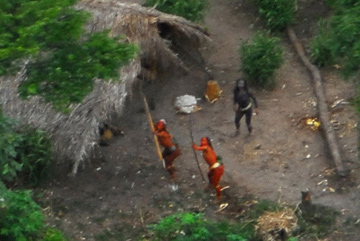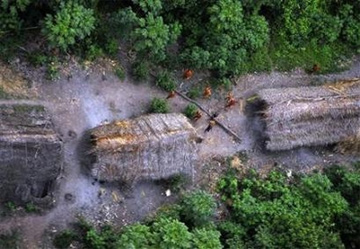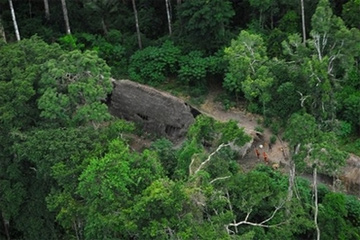Pictures of uncontacted Indian tribe spotted in the Amazon
Pictures of uncontacted Indian tribe discovered in the Amazon
mongabay.com
May 30, 2008
A helicopter fly-over of a remote part of the Brazilian Amazon captured photos of what is believed to be one of the world’s last uncontacted tribes, reports a group that works to protect indigenous peoples.
Images released by London-based Survival International show an angry response from members of the tribe — warriors in red war paint took aim at the chopper with bows and arrows.
The photos, taken by José Carlos dos Reis Meirelles Junior of FUNAI, the Brazilian government’s Indian affairs department, were released to bring attention to encroachment on indigenous lands near the border with Peru. Brazil says illegal loggers from Peru are threatening tribes deep in the Amazon rainforest.
     Uncontacted tribe in the Terra Indigena Kampa e Isolados do Envira, Acre state, Brazil, near the border with Peru. © Gleison Miranda/FUNAI. Images made available by Survival International. |
“We did the overflight to show their houses, to show they are there, to show they exist,” said José Carlos dos Reis Meirelles Junior, an uncontacted tribes expert. “This is very important because there are some who doubt their existence.”
Little known group
Meirelles told The Associated Press (AP) that anthropologists have been aware of the group for about 20 years but that little is known about them. FUNAI estimates there may be as many as 68 uncontacted tribes in Brazil, although only two dozen or so have have been officially confirmed.
Researchers suspect the group is related to the Tano and Aruak tribes, but the band may have isolated itself following interaction with miners, loggers, or rubber tappers who often make their way deep into the Amazon rainforest.
“It’s a choice they made to remain isolated or maintain only occasional contacts, but these tribes usually obtain some modern goods through trading with other Indians,” anthropologist Bernardo Beronde told the AP.
Painted red and ready to fight
Survival International says that the behavior of the tribe makes it clear they want to remain uncontacted.
Speaking with the Mail Online, Survival’s Miriam Ross said tribe members were not painted during the first overflight of their village. During later overflights the tribe appeared ready to fight, carrying weapons and painted with war colors.
“Tribes in the Amazon paint themselves for all kinds of different reasons – one of which includes when they feel threatened or are aggressive,” Ross was quoted as saying. “And they are almost certain to feel threatened by or aggressive towards a plane.”
“The jungle is fundamental to their lives and survival. It’s their home, their source of food, the source of their culture etc. Without it, they could not exist as a people.”
Uncontacted groups increasingly rare
Survival estimates they are more than one hundred uncontacted tribes worldwide — with more than half living in either Brazil or Peru — but says these groups are at risk of displacement by developers, miners, and colonists.
While the Brazilian government used to make efforts to contact such groups, today its policy is to isolate them for their own protection. Should they want contact with the outside world it is their own decision.
FUNAI estimates that are as many as 68 “uncontacted” groups in the country, but only 24 have been officially confirmed, according to the AP.
Uncontacted tribes are particularly vulnerable to disease to which they have no resistance. In the past, first contact with the outside world has lead to large-scale die-offs of indigenous people. For example, some anthropologists believe diseases introduced by European explorers in the 15th and 16th century may have killed off more than 90 percent of the indigenous population living in the Americas. Some of the only groups to survive were those who lived or moved deep in the Amazon rainforest.
More recently, at least half the Murunahua tribe in Peru died of colds and other diseases following their first contact with the outside world in 1996, according to David Hill of Survival International. The Yanomamo tribe in the Venezuela-Brazil border area suffered similar losses when miners invaded their territory in the 1970s and 1980s.

Deforestation in the Brazilian Amazon fell by more than 60 percent between 2004 and 2007, but increased in the second half of 2007. Nearly 400,000 square kilometers of forest have been cleared in the past 20 years. |
Brazil has some 350,000 Indians — the majority of whom live on indigenous reserves which cover nearly 13 percent of the country and 26 percent of the Brazilian Amazon. The extent of Indian territories is almost double the size of all state and federal protected areas and have been shown to be effective in reducing deforestation and the incidence of fire.
Still forest loss in Brazil continues to be substantial, especially as agricultural Growing agricultural production in the Amazon means that commodity prices are increasingly linked with forest clearing. As grain and beef prices surged in the second half of 2007, so did deforestation: after a three-year decline in forest loss, deforestation rates more than doubled between August 2007 and the end of the year. Ambitious plans for new infrastructure projects in the region are expected to drive further agricultural expansion.
Related
Uncontacted Amazon tribe spotted by plane in Peru (October 21, 2007) A group of uncontacted indigenous tribesmen were spotted by plane in a remote part of the Peruvian Amazon last month, according to Survival International. The region is threatened by illegal mahogany loggers.
Unknown tribe found in the Amazon (June 4, 2007) An unknown Indian tribe has been discovered in the Amazon rainforest reports the Associated Press. The Metyktire tribe, with about 87 members, was found in late May around 1,200 northwest of Rio de Janeiro. Brazil’s Federal Indian Bureau (FUNAI) says the tribe is a subgroup of the Kayapo tribe and lives on the Kayapos’ 12.1-million-acre Menkregnoti Indian reservation.
Ancient Amazonian technology could save the world (May 17, 2007) Terra preta, the ancient charcoal-based soil used by ancient Amazonians to create permanently fertile agricultural lands in the rainforest, is getting serious consideration as a means to fight global warming and meet domestic energy demand, reports an article in Scientific American. The soil, easily distinguished from conventional Amazon earth by its black color and mineral richness, is thought to have been created by pre-Columbian people through a process of adding charcoal and animal bones to regular soil to create a highly fertile hybrid, ideal for agriculture.
Amazon natives use Google Earth, GPS to protect forest home (November 14, 2006) Deep in the most remote jungles of South America, Amazon Indians (Amerindians) are using Google Earth, Global Positioning System (GPS) mapping, and other technologies to protect their fast-dwindling home. Tribes in Suriname, Brazil, and Colombia are combining their traditional knowledge of the rainforest with Western technology to conserve forests and maintain ties to their history and cultural traditions, which include profound knowledge of the forest ecosystem and medicinal plants. Helping them is the Amazon Conservation Team (ACT), a nonprofit organization working with indigenous people to conserve biodiversity, health, and culture in South American rainforests.
Amazon Stonehenge suggests advanced ancient rainforest culture (May 14, 2006) The discovery of an ancient astrological observatory in Brazil lends support to the theory that the Amazon rainforest was once home to advanced cultures and large sedentary populations of people. Besides the well-known empires of the Inca and their predecessors, millions of people once lived in the forests and shaped the environment to suit their own needs.
More news articles on the Amazon
More news articles on indigenous people














